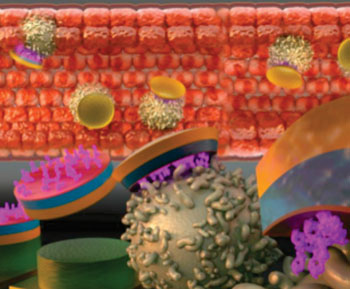Novel Drug Delivery System Capitalizes on Monocytes' Ability to Penetrate Areas of Inflammation
By LabMedica International staff writers
Posted on 19 Jan 2015
A novel experimental drug delivery system is based on disc-shaped polymeric microparticles that are attached to monocytes, white blood cells that possess a unique ability to target and penetrate into sites of inflammation.Posted on 19 Jan 2015
Investigators at the University of California, Santa Barbara (UCSB; USA) and colleagues at the Massachusetts Institute of Technology (Cambridge, MA, USA) selected the disc shape, since a nonspherical flexible shape is more durable and resistant to phagocytosis than is a rigid spherical particle.

Image: Disc-shaped microparticles use monocytes to get to their destination (Photo courtesy of the University of California, Santa Barbara).
In a paper published in the December 3, 2014, online edition of the Journal of Controlled Release, the investigators described how they capitalized on the natural ability of monocytes to target and deliver flat polymeric particles, which they called "cellular backpacks," to inflamed tissues. The cellular backpacks attached strongly to the surface of monocytes but did not undergo phagocytosis. Following attachment of backpacks, monocytes retained important cellular functions including transmigration through an endothelial monolayer and differentiation into macrophages.
In future experiments, cellular backpacks loaded with drugs will be injected into the bloodstream, whereupon they should attach to circulating monocytes and "hitchhike" to the target region. At the site of inflammation, the particles will degrade and release their drugs.
"Basically the main benefit is that you can deliver the drug in a more effective dose," said senior author Dr. Samir Mitragotri, professor of chemical engineering at the UCSB. "Take, for example, the case of chemotherapy, which often has a narrow therapeutic range: too little and the treatment is not effective, too much and it can be lethal. Because chemo travels through the bloodstream and affects all the tissues it comes in contact with, dosages are restricted at least in part based on the deleterious effect it has on other, unafflicted organs and their functions. Not only can targeted therapy ensure other body systems remain unaffected, but it could allow for higher doses of drug to the site, which could decrease treatment time. Many diseases result in inflammation. If we could target the common denominator, whether the inflammation is coming from cancer or arthritis, we could deliver the drug there."
Related Links:
University of California, Santa Barbara
Massachusetts Institute of Technology













